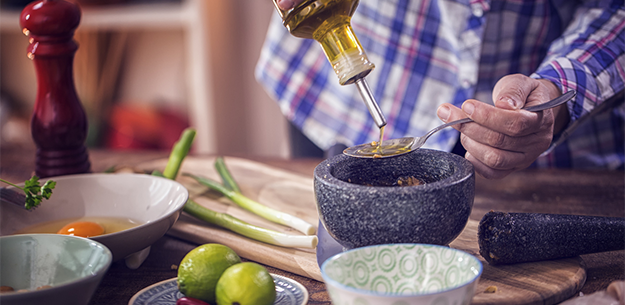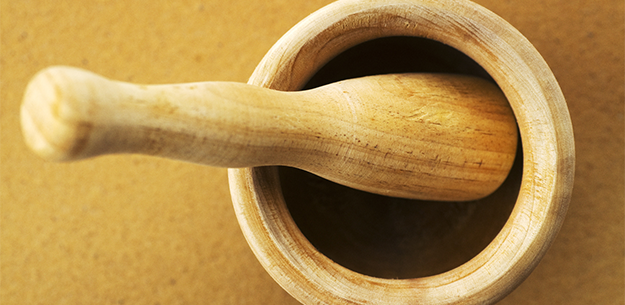.png.transform/rendition-xs/image_image%20(1).png)
Mortar and Pestle
The most basic utensil in the traditional Spanish kitchen is the mortar and pestle (mortero or almirez, in Spanish). Of weighty granite or marble, of gnarled olive wood or shiny brass, the mortar holds pride of place on the kitchen shelf. Before the advent of electric blenders, it was a tool in daily use, the starting point of many recipes.
The tool is the technique (called in Spanish majar)—a few peppercorns, garlic, a wisp of saffron are crushed in the mortar and added to a simmering stew. Here is where flavor begins.
Each region has developed distinctive recipes using the mortar. Andalusia has its ajoblanco, cold almond soup, and chicken in pepitoria sauce (made with saffron). La Mancha has morteruelo, a sort of game meat pâté. Catalonia has romesco sauce and picada, a ground nut mixture for flavoring fish stews, chicken and meat dishes.
In some regions, such as Andalusia, Extremadura and Castile-León favor the almirez, a small brass mortar and pestle. So beloved is the sound of the almirez that it is used as a rhythm instrument in traditional folk music.
In a collection of recipes from Málaga (Andalusia), the gastronomic writer Enrique Mapelli recounts how making ajo blanco was a summertime ritual. Village women would sit in their doorways with the almirez, pounding garlic, almonds and bread to a smooth paste. Olive oil beaten into the paste created a thick emulsion, to be thinned with vinegar and cold water and served with sweet Moscatel grapes.
Traditional technique for traditional dishes
Many cooked dishes also required the almirez. A standard preparation, used for fish, poultry and meat, begins with frying until crisp a slice of bread, a few almonds, and a clove or two of garlic. Next, small hard ingredients-a few peppercorns, a single clove, a few threads of saffron-are ground in the brass mortar. Then, the fried bread, almonds and garlic- plus a clove of raw garlic, for subtle variations in flavor- are added to the mortar and "processed" to make a paste. Diluted with white wine, the mixture goes into the cazuela or casserole where chicken or hen has been browned. The mortar mixture creates the sauce, known as pepitoria, both thickening and seasoning it.
Catalan picada sauce, used to flavor suquet, a seafood stew; rabbit dishes, and a sumptuous surf and turf (mar y montaña) dish of chicken and lobster, is prepared in a large granite mortar. Almonds and sometimes pine nuts or hazelnuts are crushed with garlic, parsley, and bread. Sometimes the picada is thickened with the fried liver of fish, rabbit or chicken.
A mortar is also essential for preparing the famous Catalan romesco sauce. Dried sweet peppers called ñoras are ground up with hazelnuts and garlic, sometimes roasted tomatoes, then olive oil is beaten in to thicken the sauce.
The morteruelo of La Mancha is a traditional way of preserving pork liver and game meats. After a matanza, pig slaughtering, the liver was cut into pieces and fried, then mashed in the mortar. Combined with bread for thickening, pieces of chopped partridge and cinnamon and caraway seeds, it is simmered until very thick, then packed in pots to keep in a cold place.
Janet Mendel is a food writer based in southern Spain. She is the author of several books about Spanish food, including Cooking in Spain and Tapas: a bite of Spain (Santana Books, Spain); My Kitchen in Spain and Cooking from the Heart of Spain-Food of La Mancha (Harper Collins), and Traditional Spanish Cooking (Frances Lincoln, UK).


- Mortar and Pestle 1
- Mortar and Pestle 2
